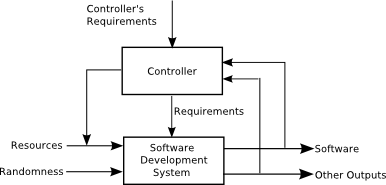©2007 Donald E. Gray
Models are like kitchen utensils. You need a variety of them, and you should know when and how to use them. They should be useful for more than a single task. I recently started exploring the first explicit model I learned years ago.
The Cybernetic Model
One of my more interesting college classes was feedback control. The class was based on differential equations, Laplace transforms, and a single model that looked like this:

This model is the basis for most of the process control in the world. The controller compares the setpoint to the actual value.The controller uses the error information to take corrective action. If the temperature is too hot, the corrective action might be to reduce the heat in the temperature jacket. After a while, things cool down. All processes have a time lag between the corrective action and when the change arrives at the output. I “borrowed” the “delay symbol” from Causal Loop Diagramming to show this. If it gets too cool, the controller will change the action and add more heat.
I didn’t realize at the time how powerful and versatile this diagram is.
Personal Problem Solving
With just a few word changes, the model can be used to describe how people can solve their problems.

A problem exists when a difference exists between what we want, and what we have. We can solve the problem by changing our actions, and seeing if the world at large responds with results that are closer to what we desire.
I’m trying to lose a few pounds. I can change what I eat (calories, fat, carbs, pick your favorite fad diet). I can change how often I exercise. If I continue with these changes, eventually I should lose the weight.
Project Management
Change a couple of more words, and now we have a project management tool.

In this drawing, I’ve used a dash line connection between the manager (in this case synonymous with leader) and the team. I made this distinction since managers don’t have a direct linkage to the team. Managers can ask, cajole, threaten, and perhaps fire team members who don’t perform the tasks they’ve been asked to do. But the team member always has a choice.
Loops All the Way Down
It is possible to nest the cybernetic model. Consider the Scrum sprint cycle. The sprint cycle overview looks like:

The outside loop is the sprint cycle (usually 30 days or less). Every sprint the product owner sees new product functionality. They compare the current product state with the target and prioritize the remaining user stories. The product owner and team select a subset of the remaining stories which becomes the current sprint backlog.Completing the sprint backlog is the goal (setpoint) for the inside loop. Every day during the sprint, the Scrum team tracks how it’s progressing toward the sprint goal during the daily standup meeting.
A Rose is a Rose
In QualitySoftware Management Volume 1, Systems Thinking Jerry (Gerald M.) Weinberg presents the model in a slightly different picture (page 62).

Jerry says, “The feedback model of a software development system requires feedback of information about the system’s performance, plus requirements for the controller to compare with that information. This is the model that distinguishes Pattern 3 from Patterns 0, 1, and 2. It is also used by Patterns 4 and 5.”
This presentation highlights two systems aspects:
- Randomness. All systems interact with their environment. Changes in the environment create changes in the system whether the changes are planned or not.
- The software development system creates “other outputs” that the controller can use to improve the overall system performance.
A Good Place to Start
Like kitchen utensils, you need many different models. I keep a list of models I use here. The list includes:
- the Cybernetic Model
- Diagrams of Effect
- Behavior Over Time Graphs
- systems archetypes
- the Satir Interaction Model
- the Satir Transformation Models
- MBTI (and temperaments)
- abstracting (Korzybski)
- abstraction (Hayakawa)
- the NLP Meta-Model
- meta-programs
- intake modalities
- the Rule of Three
I didn’t consciously start the list with the Cybernetic Model, but that’s where it belongs. Any time I start with a difference between what I want and have, I’ve already started using the Cybernetic Model. I may choose to use other models to help resolve the difference between my desires and perceptions.For instance, if I’m involved in a conversation that doesn’t make sense, I may use the Satir Interaction model to find out why the conversation doesn’t make sense. If a co-worker’s actions don’t make sense, maybe I’ll use MBTI types to shed light on the problem.
But it all starts with the multi-use, handy-dandy, Cybernetic Model.
